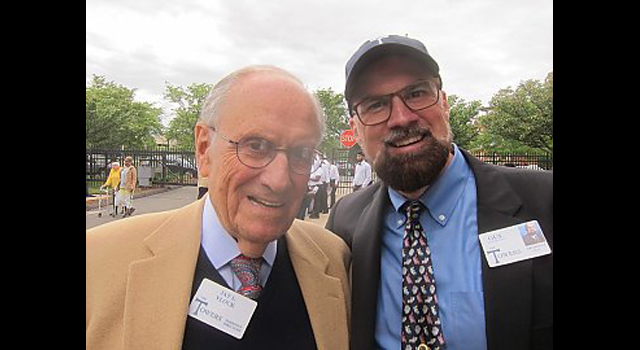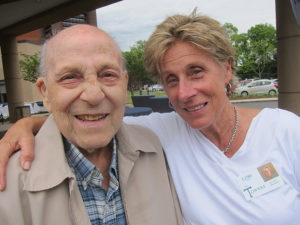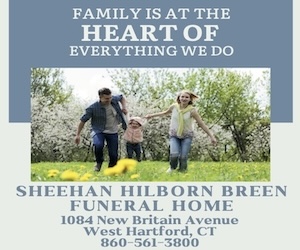
By Allan Appel
Reprinted with permission of New Haven Independent (www.newhavenindependent.org).
NEW HAVEN – Ninety-two-year old Frank Mattei fought in Okinawa in World War Two then came home to a long career with the Bradley Smith Company of lollipop fame on Grand Avenue in New Haven.
When he first moved into The Towers senior complex back in 1988, the lobby was much smaller, as was the dining area, and there was no bank, convenience store, or hair salon as there are now.
If the The Towers are to be successful for the next 50 years, they are going to have to make changes far more dramatic to attract Baby Boomers – old people who just don’t want to hang out strictly with other old people.
That double message of proud nostalgia for New Haven’s first and premier senior complex alongside intense strategic planning for new generations of the elderly emerged at a 50th birthday party held Wednesday evening, June 6, at the twin-tower community at New Haven’s Church Street and MLK Boulevard.
The festive event with attracted more than 200 residents, family members and friends to two large white tents set up in the parking area adjacent to the Tower One building, which was erected in 1968. [The June 6 event was one in a series of 50th anniversary events that kicked off with a community-wide celebration in September 2017; see “Tower One celebrates 50 years of affordable housing and independent living for seniors,” Jewish Ledger, Sept. 8, 2017.]
The complex’s new president and CEO, Gus Keach-Longo, used the occasion to announce that Tower One and its sister building Tower East, built in 1971, have financially merged through a refinancing. He also declared that a new logo and joint institutional name change – to “The Towers” – are now official.
One of The Towers’ founders, Jay Vlock (the other still living founder Linda Kantor was also present) recalled how affordable senior housing – an innovation in the late 1960s – came to New Haven.
In 1964 he was at business conference among fellow architects in St. Louis when an advocate for this newfangled idea approached him and told him there was $48 million in Washington earmarked in new federal legislation for senior housing, provided it be built by a nonprofit.
“I was a member of [then New Haven Mayor] Dick Lee’s kitchen cabinet,” Vlock said. So he made an appointment with the mayor. “Dick, do you know anything about senior housing?” he asked.
“‘I don’t,’” Vlock recalled Lee responding, “‘but I will in an hour.”
And in an hour Vlock said he received a phone call from the mayor: “Dick Lee said, ‘Get your ass down here.’”
Lee, who famously had access to the fastest and widest pipeline for urban federal dollars in the country, told Vlock to recruit a nonprofit to sponsor and to build the complex in the middle of city. Those were the requirements. The latter “so people can get to see their parents and not forget about them in the sticks” and also so they can walk into New Haven.
Linda Kantor, one of the movers of the Jewish Community Council, signed on as the sponsoring nonprofit, and the project was launched. Kantor and Vlock recalled that a series of battles ensued with officials of the Housing and Urban Development Department (HUD), which administered the funding. They had to fight for communal dining for the complex, Vlock said, and for some medical facilities, and even to have the place carpeted as opposed to tiled. “A carpet, because this is their home,” Kantor recalled arguing.
Vlock pointed out that tiles are hard. If you’re old and you fall, there’s more chance of injury. HUD, he said, was operating under the notion of building a dormitory. Leadership of The Towers, as it evolved, argued for building a building that could also build community.
That challenge – continuing to build community – in future years was at the heart of Keach-Longo’s address Wednesday night.
“People are coming to us at a later age,” he said. They were in their late 60s back in the early years of The Towers and, like Mattei, stayed much longer. Now many people are arriving in their late 80s. They are frailer and require additional care, both personal, physical and emotional.
The newly arrived leader – he’s been on the job about a year – launched a listening tour. He launched a formal strategic planning process, while also raising $100,000 in a special campaign on the occasion of the 50th birthday.
He spoke of the increasing care required of the growing percentage of The Towers elderly residents who are not coming to dinner, and who report isolation and depression. About 40 percent of dwellers in the 328 apartments describe themselves as lonely, he reported, He put out a call for volunteers to form relationships with Towers residents, especially about 15 he said who have been identified as self-shut-ins. He solicited donations for “life enhancement activities, bereavement support, and counseling.”
He might also have included cultural activities, like the many music programs that opera buff Frank Mattei called one of the particular pleasures of his 30 years at the complex.
Keach-Longo said the future of The Towers will pivot equally on what ways the complex retools itself in order to attract Baby Boomers who may want different kinds of assets to be in the complex or nearby – a restaurant or a theater, for example, he said.
More Integrated Into New Haven
The keynote speaker for the 50th anniversary soiree was city Economic Development Administrator Matt Nemerson, who spoke of how not just the Towers, but the surrounding stretch of the Hill neighborhood are at a turning point.
He cited the Hill-to-Downtown development that Randy Salvatore is soon to start building across from the The Towers on Gold Street. He cited the reconnecting of Orange Street across Route 34. And noted that The Towers’ neighbor, the Church Street South low-income housing development, is now about to be torn down and replaced with a mixed-income development of 900 apartments.
The Towers’ now overgrown basketball court and strip of land, which Church Street South residents used for years, will now be returned to The Towers for potential future use by the city, Nemerson said. Until now the Towers has granted an easement granted to Church Street for use of that property.
Nemerson and other city officials said after the gathering they are skeptical that in the current financial and political environment money can be found for a new building. Nemerson suggested that restaurants and stores in the to-be-developed properties that surround The Towers on three sides might help Baby Boomer future residents of the Towers not feel shut off from city life.
While the planning goes on, Keach-Longo said The Towers will announce its forward-looking posture with large 30-foot banners along with redesigns of the dining room and cafe areas. He learned on his listening tour that some residents are not coming down to eat due to the noise in the larger room. He spoke of designing quieter, more intimate spaces, along with more agreeable waiting areas in the main lobby – all affordable, he said, even in cash-strapped times.
CAP: Jay Vlock, one of the founders of The Towers, and the complex’s new president and CEO Gus Keach-Longo discuss the past and future.








 Southern New England Jewish Ledger
Southern New England Jewish Ledger











